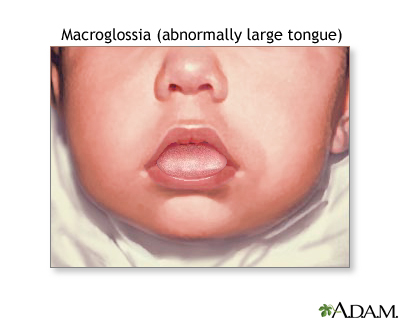Health Library
Macroglossia
Macroglossia is a disorder in which the tongue is larger than normal.
Images



I Would Like to Learn About:
Information
Macroglossia is most often caused by an increase in the amount of tissue in the tongue, rather than by a growth, such as a tumor.
This condition can be seen in certain inherited or congenital (existing at birth) disorders, including:
- Acromegaly (buildup of too much growth hormone in the body)
- Beckwith-Wiedemann syndrome (growth disorder that causes large body size, large organs, and other symptoms)
- Congenital hypothyroidism (decreased production of thyroid hormone)
- Diabetes (high blood sugar caused by body producing too little or no insulin)
- Down syndrome (extra copy of chromosome 21, which causes problems with physical and intellectual functioning)
- Lymphangioma or hemangioma (malformations in the lymph system or buildup of blood vessels in the skin or internal organs)
- Mucopolysaccharidoses (a group of diseases that cause large amounts of sugar to build up in the body's cells and tissues)
- Primary amyloidosis (a buildup of abnormal proteins in the body's tissues and organs)
References
Alwani MM, Makki FM, Robbins KT. Physiology of the oral cavity. In: Flint PW, Francis HW, Haughey BH, et al, eds. Cummings Otolaryngology: Head and Neck Surgery. 7th ed. Philadelphia, PA: Elsevier; 2021:chap 86.
Rose E. Pediatric upper airway obstruction and infections. In: Walls RM, ed. Rosen's Emergency Medicine: Concepts and Clinical Practice. 10th ed. Philadelphia, PA: Elsevier; 2023:chap 162.
Sankaran S, Kyle P. Abnormalities of the face and neck. In: Coady AM, Bowler S, eds. Twining's Textbook of Fetal Abnormalities. 3rd ed. Philadelphia, PA: Elsevier Churchill Livingstone; 2015:chap 13.
BACK TO TOPReview Date: 4/28/2023
Reviewed By: Neil K. Kaneshiro, MD, MHA, Clinical Professor of Pediatrics, University of Washington School of Medicine, Seattle, WA. Also reviewed by David C. Dugdale, MD, Medical Director, Brenda Conaway, Editorial Director, and the A.D.A.M. Editorial team.
 | A.D.A.M., Inc. is accredited by URAC, for Health Content Provider (www.urac.org). URAC's accreditation program is an independent audit to verify that A.D.A.M. follows rigorous standards of quality and accountability. A.D.A.M. is among the first to achieve this important distinction for online health information and services. Learn more about A.D.A.M.'s editorial policy, editorial process and privacy policy. A.D.A.M. is also a founding member of Hi-Ethics. This site complies with the HONcode standard for trustworthy health information: verify here. |
The information provided herein should not be used during any medical emergency or for the diagnosis or treatment of any medical condition. A licensed medical professional should be consulted for diagnosis and treatment of any and all medical conditions. Links to other sites are provided for information only -- they do not constitute endorsements of those other sites. No warranty of any kind, either expressed or implied, is made as to the accuracy, reliability, timeliness, or correctness of any translations made by a third-party service of the information provided herein into any other language. © 1997- 2024 A.D.A.M., a business unit of Ebix, Inc. Any duplication or distribution of the information contained herein is strictly prohibited.
